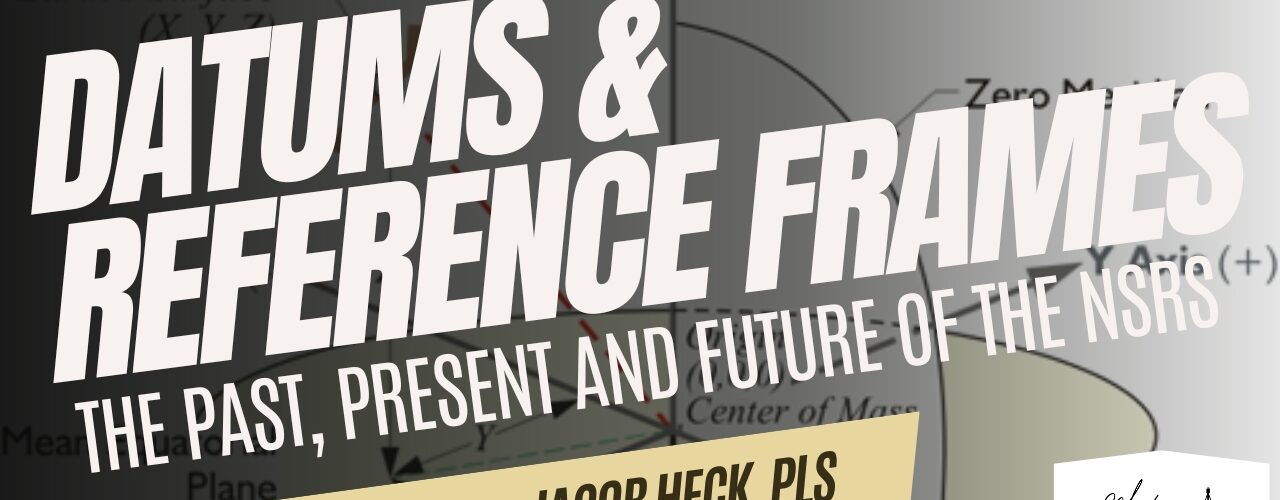Jacob Heck, PLS, presents on Datums & Reference Frames: The Past, Present, and Future of the NSRS.
| Summary | |
| State Conferences, Attendance, and NGS Updates | |
| Jacob, Trent, Jerry, and Joanne discussed the attendance and organization of state conferences. Trent missed the Las Vegas Conference due to scheduling issues, but Jerry confirmed that the Wisconsin conference attracts between 1,000 to 1,300 attendees, with many from neighboring states. Joanne shared her goal of breaking even for their state’s conference and mentioned potential future participation from Hawaii. Additionally, Jacob, a geologist from the National Geodetic Survey, introduced himself to the team and shared that he would be covering the responsibilities of the regional advisor branch team due to staff changes. He also informed the team about the retirement of the previous director of NGS, Julianna Blackwell, after 15 years in the position. | |
| NGS Project Progress and Challenges | |
| Jacob presented an overview of the progress and challenges of the National Geodetic Survey (NGS) project. He discussed the importance of the project in improving geospatial data accuracy and its significance in various fields, including mapping, navigation, and emergency services. He also highlighted the crucial role of NGS in providing reference data for other organizations, such as the U.S. Geological Survey (USGS) and the Federal Aviation Administration (FAA). Jacob further outlined the project’s current status, including the completion of the gravity data collection in 2020, the ongoing development of the geoid model, and the reallocation of resources to finalize state plan coordinates. He concluded by emphasizing the importance of public awareness and preparation for the eventual adoption of the new geodetic system. | |
| Consistency in Geospatial Frameworks and NSRS Modernization | |
| Jacob discussed the importance of a consistent framework for applications using survey data, such as engineering, floodplain mapping, and precision agriculture. He elaborated on the modernization of the National Spatial Reference System (NSRS) to integrate various geodetic techniques and provide a more comprehensive and consistent framework. He also highlighted the collaborative efforts of the National Geodetic Survey (NGS) with other countries under the United Nations (UN) framework to ensure consistency worldwide. Furthermore, he emphasized the role of the UN Subcommittee on Geodesy in implementing this globally and the contribution of NGS as an analysis center to the International GNSS Service. | |
| Transition to Active Control Methods | |
| Jacob presented a transition from passive to active control methods for data collection, highlighting the benefits of modern techniques like cores and opus, which offer consistent and timely data. He introduced an improved version of the data sheets and passive marks page and announced the availability of transformation tools for different coordinate systems and data sets. A discussion with Trent ensued about the challenges of dealing with old plans and systems, especially those still reliant on 27, and the need for upgrade to 88 to establish a direct link. Trent agreed to this plan, recognizing the ongoing issues requiring calculation back to 29 vertical, and they concluded that the best course of action would be to upgrade as much as possible to 88 before linking over to the app GD 2022. | |
| Recommendations and Responses | |
| The speaker commits to providing a thoughtful response based on the given task prompt, but the details of the response are not included in the transcript. | |
| Plate Fixed Reference Frames Discussion | |
| Jacob explained the creation of plate fixed reference frames for North America, the Caribbean, Hawaii, Samoa, and the Mariana Islands. He used the International Earth Rotation and Reference system service to clarify the concepts of a reference system and a reference frame. Jacob emphasized that the ITRF2022 coordinates will be tied to these reference frames and will be used in modernized NSRS across various continents. Trent commended the visual representation of the plate rotation and motion, which he found to be the best explanation he had seen. | |
| Geopotential Leveling Challenges and Solutions | |
| Jacob discussed the complexities and limitations of leveling adjustments for geopotential data, using examples from the International Great Lakes data and the VD88 and NGBD29. He explained that leveling, crucial for high accuracy over short distances, becomes challenging and costly when applied nationally or globally due to systematic errors and the need for extensive fieldwork. As an alternative, he suggested the use of airborne gravity and geoid models. Jacob also shared his involvement in the forthcoming update for the International Great Lakes data and referred to the older data from the Fourth general adjustment in 1912. No specific task prompt or response was provided, and the lack of information made it difficult to generate a relevant summary. | |
| Orthometric Height and Geoid Undulation | |
| Jacob explains the process of determining the orthometric height and geoid undulation from a model. The ellipsoid height is determined through the distance along the plumb line. The dynamic height is a scaled value of geopotential, which is the amount of energy per unit mass that water has at each equipmental surface. The geoid height is the average value of gravity along the plum line. Jacob explains that the Great Lakes basin is tilting, with an average tilt of 7mm a year over 30 years due to melting ice sheets. | |
| NSRS Importance, Modernization, and Metadata | |
| Jacob emphasized the importance of the NSRS and the need for good surveying practices to maintain the nationwide geodetic control. He highlighted the significance of metadata and consistent angles and distances for successful projects. Jacob also discussed the modernization of the NSRS and the role of geospatial modeling grants in developing new tools, including an intra-frame deformation model. Trent and Steven had no immediate questions, but Dan asked for clarifications on the use of a GPS calendar and the concepts of survey and reference epics, which were planned to be discussed in more detail in a future presentation. | |
| Opus Coordinate Types and Reporting | |
| Jacob explained the different types of coordinates related to the Opus system. He clarified that there are five new coordinate types, including active coordinates, reference epic coordinates, and survey epic coordinates. Jacob further noted that survey data can be submitted to Ngs for future reference and that Opus coordinates can be tied to Nsrs if recommendations are followed. He also introduced the concept of reported coordinates, which can be used to find passive control in the future and can be obtained from various sources, although they may not be accurate. | |
| Revised Guide for GPS Heights | |
| Jacob discussed the development and upcoming publication of a revised guide for obtaining accurate GPS heights, known as NGS 92. He mentioned this guide lays out procedures for obtaining good GPS heights and is currently under review by a division chief. He also talked about the significant improvements in GPS technology and the introduction of multi-GNSS processing software. Furthermore, he revealed his regional advisor role and ongoing work on intermediate and advanced opus project manager training. Lastly, he mentioned the publication of new videos for training purposes and the availability of updated materials for the team. | |
| Satellite Clock Systems and PPP Developments | |
| Steven and Jacob discussed the technical aspects of satellite clock systems, focusing on the difference between single and double difference solutions, and the use of International GNSS Service (IGS) products. They also touched on recent developments in PPP and the use of global clock and orbit products, as well as the functionalities of the Beta opus web page. Issues with the new system and plans for further collaboration were also discussed, with a future team meeting scheduled for April 15th and the following week’s meeting to be skipped. | |
| AI-generated content may be inaccurate or misleading. Always check for accuracy. | |







